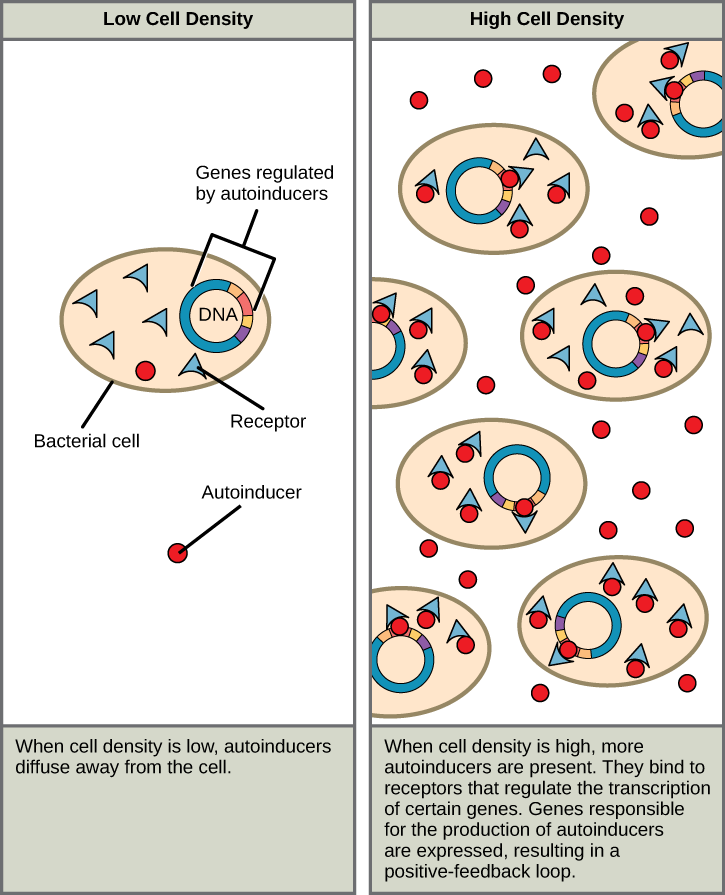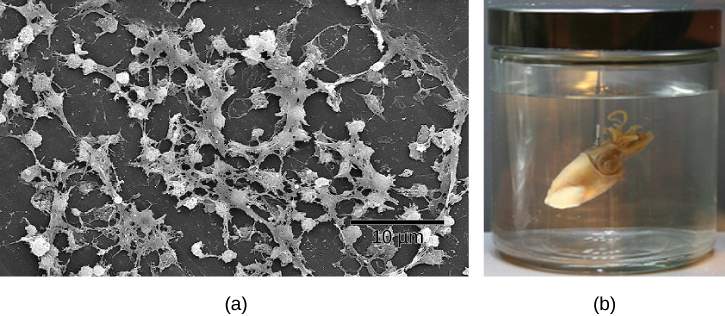| << Chapter < Page | Chapter >> Page > |

Which of the following statements about quorum sensing is false?
Some species of bacteria that use quorum sensing form biofilms, complex colonies of bacteria (often containing several species) that exchange chemical signals to coordinate the release of toxins that will attack the host. Bacterial biofilms ( [link] ) can sometimes be found on medical equipment; when biofilms invade implants such as hip or knee replacements or heart pacemakers, they can cause life-threatening infections.

What advantage might biofilm production confer on the S. aureus inside the catheter?
Research on the details of quorum sensing has led to advances in growing bacteria for industrial purposes. Recent discoveries suggest that it may be possible to exploit bacterial signaling pathways to control bacterial growth; this process could replace or supplement antibiotics that are no longer effective in certain situations.
Watch geneticist Bonnie Bassler discuss her discovery of quorum sensing in biofilm bacteria in squid.
Yeasts are single-celled eukaryotes, and therefore have a nucleus and organelles characteristic of more complex life forms. Comparisons of the genomes of yeasts, nematode worms, fruit flies, and humans illustrate the evolution of increasingly complex signaling systems that allow for the efficient inner workings that keep humans and other complex life forms functioning correctly.
Kinases are a major component of cellular communication, and studies of these enzymes illustrate the evolutionary connectivity of different species. Yeasts have 130 types of kinases. More complex organisms such as nematode worms and fruit flies have 454 and 239 kinases, respectively. Of the 130 kinase types in yeast, 97 belong to the 55 subfamilies of kinases that are found in other eukaryotic organisms. The only obvious deficiency seen in yeasts is the complete absence of tyrosine kinases. It is hypothesized that phosphorylation of tyrosine residues is needed to control the more sophisticated functions of development, differentiation, and cellular communication used in multicellular organisms.
Because yeasts contain many of the same classes of signaling proteins as humans, these organisms are ideal for studying signaling cascades. Yeasts multiply quickly and are much simpler organisms than humans or other multicellular animals. Therefore, the signaling cascades are also simpler and easier to study, although they contain similar counterparts to human signaling.
G. Manning, G.D. Plowman, T. Hunter, S. Sudarsanam, “Evolution of Protein Kinase Signaling from Yeast to Man,”
Trends in Biochemical Sciences 27, no. 10 (2002): 514–520.
Watch this collection of interview clips with biofilm researchers in “What Are Bacterial Biofilms?”
Yeasts and multicellular organisms have similar signaling mechanisms. Yeasts use cell-surface receptors and signaling cascades to communicate information on mating with other yeast cells. The signaling molecule secreted by yeasts is called mating factor.
Bacterial signaling is called quorum sensing. Bacteria secrete signaling molecules called autoinducers that are either small, hydrophobic molecules or peptide-based signals. The hydrophobic autoinducers, such as AHL, bind transcription factors and directly affect gene expression. The peptide-based molecules bind kinases and initiate signaling cascades in the cells.
[link] Which of the following statements about quorum sensing is false?
[link] C.
[link] What advantage might biofilm production confer on the S. aureus inside the catheter?
[link] S. aureus produces a biofilm because the higher cell density in the biofilm permits the formation of a dense surface that helps protect the bacteria from antibiotics.

Notification Switch
Would you like to follow the 'Biology' conversation and receive update notifications?